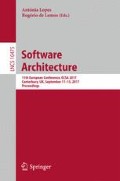Abstract
Autonomous vehicles are slowly becoming reality thanks to the efforts of many academic and industrial organizations. Due to the complexity of the software powering these systems and the dynamicity of the development processes, an architectural solution capable of supporting long-term evolution and maintenance is required.
Continuous Experimentation (CE) is an already increasingly adopted practice in software-intensive web-based software systems to steadily improve them over time. CE allows organizations to steer the development efforts by basing decisions on data collected about the system in its field of application. Despite the advantages of Continuous Experimentation, this practice is only rarely adopted in cyber-physical systems and in the automotive domain. Reasons for this include the strict safety constraints and the computational capabilities needed from the target systems.
In this work, a concept for using Continuous Experimentation for resource-constrained platforms like a self-driving vehicle is outlined.
Access this chapter
Tax calculation will be finalised at checkout
Purchases are for personal use only
References
Giaimo, F., Berger, C.: Design criteria to architect continuous experimentation for self-driving vehicles. In: Proceedings of the International Conference on Software Architecture, ICSA 2017. IEEE, New York (2017)
Giaimo, F., Yin, H., Berger, C., Crnkovic, I.: Continuous experimentation on cyber-physical systems: challenges and opportunities. In: Proceedings of the Scientific Workshop Proceedings of XP2016, p. 14. ACM (2016)
Fagerholm, F., Guinea, A.S., Mäenpää, H., Münch, J.: The right model for continuous experimentation. J. Syst. Softw. 123, 292–305 (2017)
Olsson, H.H., Bosch, J.: Climbing the stairway to heaven: evolving from agile development to continuous deployment of software. In: Bosch, J. (ed.) Continuous Software Engineering, pp. 15–27. Springer, Heidelberg (2014)
Tang, D., Agarwal, A., O’Brien, D., Meyer, M.: Overlapping experiment infrastructure: more, better, faster experimentation. In: Proceedings of the 16th ACM SIGKDD International Conference on Knowledge Discovery and Data Mining, pp. 17–26. ACM (2010)
Kohavi, R., Deng, A., Frasca, B., Walker, T., Xu, Y., Pohlmann, N.: Online controlled experiments at large scale. In: Proceedings of the 19th ACM SIGKDD International Conference on Knowledge Discovery and Data Mining, KDD 2013, pp. 1168–1176. ACM, New York (2013)
Amatriain, X.: Beyond data: from user information to business value through personalized recommendations and consumer science. In: Proceedings of the 22nd ACM International Conference on Information & Knowledge Management, pp. 2201–2208. ACM (2013)
Kirchner, C.: Assessing safety aspects for continuous experimentation on the example of automated driving. Master’s thesis, RWTH Aachen, February 2017
Navet, N., Simonot-Lion, F.: Automotive Embedded Systems Handbook. CRC Press, Boca Raton (2008)
ReVeRe - Research Vehicle Resource at Chalmers. https://www.chalmers.se/safer/EN/projects/pre-crash-safety/projects/revere-research-vehicle. Accessed 14 Jan 2017
Runeson, P., Höst, M.: Guidelines for conducting and reporting case study research in software engineering. Empirical Softw. Eng. 14(2), 131 (2009)
COPPLAR Project - CampusShuttle cooperative perception and planning platform. https://www.chalmers.se/safer/EN/projects/pre-crash-safety/projects/copplar-campusshuttle. Accessed 14 Jan 2017
Acknowledgment
This work has been supported by the COPPLAR Project – CampusShuttle cooperative perception and planning platform [12], funded by Vinnova FFI, Diarienr: 2015-04849.
Author information
Authors and Affiliations
Corresponding author
Editor information
Editors and Affiliations
Rights and permissions
Copyright information
© 2017 Springer International Publishing AG
About this paper
Cite this paper
Giaimo, F., Berger, C., Kirchner, C. (2017). Considerations About Continuous Experimentation for Resource-Constrained Platforms in Self-driving Vehicles. In: Lopes, A., de Lemos, R. (eds) Software Architecture. ECSA 2017. Lecture Notes in Computer Science(), vol 10475. Springer, Cham. https://doi.org/10.1007/978-3-319-65831-5_6
Download citation
DOI: https://doi.org/10.1007/978-3-319-65831-5_6
Published:
Publisher Name: Springer, Cham
Print ISBN: 978-3-319-65830-8
Online ISBN: 978-3-319-65831-5
eBook Packages: Computer ScienceComputer Science (R0)

